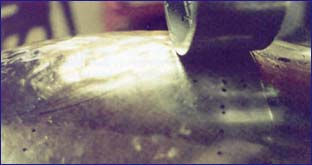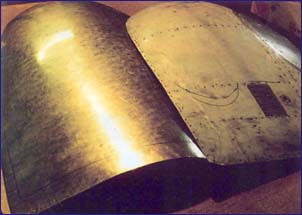Back to Part 3
|

Smoothing with the wheel. The little black dots are register marks needed to align the new panel very closely
to the old, preventing misalignment. |
However, the resultant temper is inexact and is more suited to careful hobbyists and homebuilders. 6061 is
readily weldable but because of the heat treatable nature of the material, the welding process will
change the temper unpredictably at the weld zone.
7075-(705) has a nominal composition of 5.6% zinc, 2.5% magnesium, 1.6% copper, and 0.3% chromium. Since its
yield is high, 15K51 to 67K51, it is decidedly a structural alloy, and finds use as spars, springs,
stringers, framework, bulkheads, and carrythroughs. Very similar to 2024 in application, it is
non-weldable, work hardens fairly fast, and partially anneals from
650
0
F,
after being held for two to three hours. Full anneal requires a dual stage process and is not recommended for
the torch in any case.
|

Now finished, the panel was fitted very closely to the original, and then heat treated, but not artificially
aged. The panel arrived from heat treat in 0 condition, and was then worked again, to both remove
the distortion and to recover the lost fit. As the 2024 naturally age hardens, there is a bit of
a foot race to get it back in the shop to get it refitted because it rehardens in about four
days. The surface finish is bright, the ALCLAD is thinner but intact, and there is a whisper of
orange peel - a metallurgical term for surface grain roughness caused by heavy working. The
finished temper designation is T81. |
2017 and 2117 are both used as high strength rivets. The icebox method is a reliable way to keep the rivet
soft at a low temperature, necessary for suspending the aging process. After setting the rivet in the
soft condition, it gradually ages to full hardness after it returns to ambient temperature - unless the
ambient still happens to be sub-freezing!
Due to the necessary length of this article, it was not possible to cover more of the tempering process.
Tempering, along with the aging and annealing, processes, will be covered completely in a future article.
More information about straightening damaged aircraft parts, making new ones, and the specific related
processes will be addressed in future articles.
Recommended reading . . . The Standard Aviation Maintenance Handbook from Jeppesen Sanderson.
Back to Articles by the Tinman





